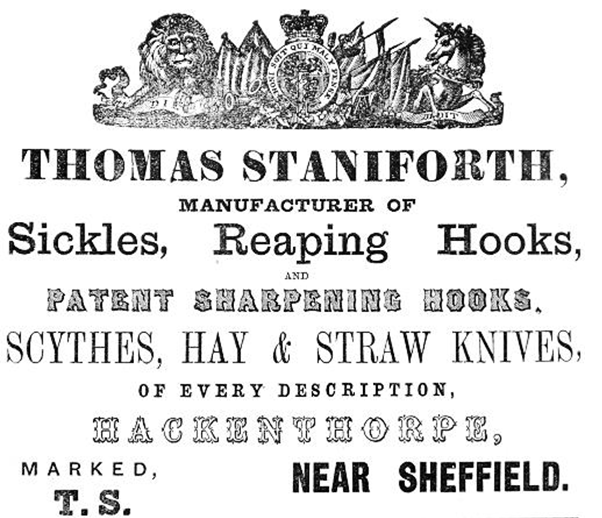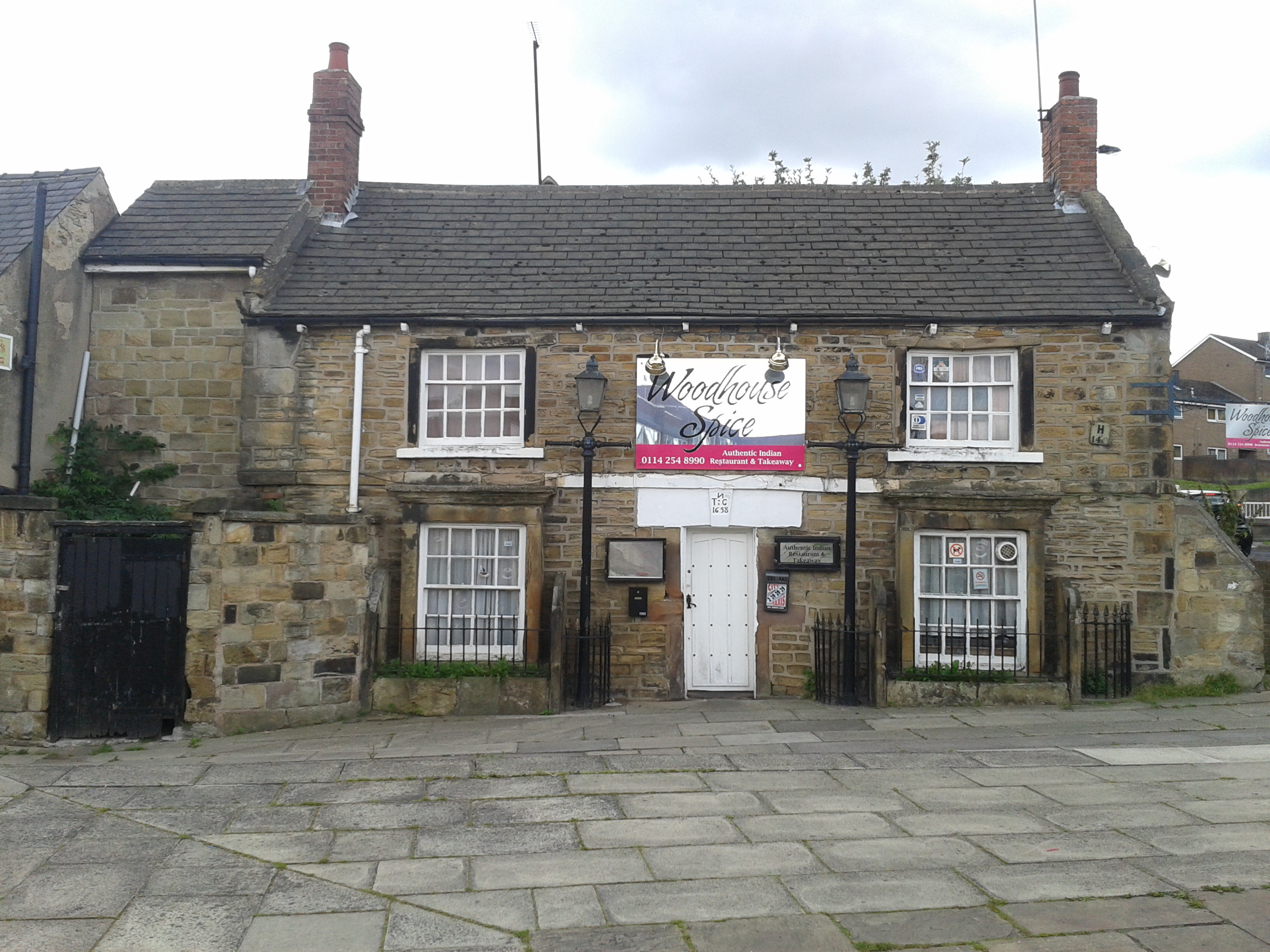
Thomas Staniforth & Co. Sickle works at Hackenthorpe.
 The Cross Daggers, Woodhouse
The Cross Daggers, Woodhouse
John Staniforth was born on May 29th 1805 to John Staniforth and Mary Hurt. He was baptised on June 23rd at St. Mary’s Beighton. John had an elder brother named William born in 1795, however he passed away in 1797, making him the eldest surviving son. On parish records John is described as a Sicklesmith, which proves that despite his father John passing away in 1813, his mother made sure to put him in an apprenticeship. John would have been raised with his sisters and only surviving brother Thomas Staniforth.
In 1833 John Staniforth married Mary Carnall, we get a great account from an article written seventy years later in The Woodhouse Express which states ‘…prior to undertaking the serious business of making a living (for which they had adequate arrangements) the newly wedded couple with several of their friends drove over the moors to the Wheatsheaf at Baslow, which was kept b another friend of theirs, Mr. Ingleby, and there they all stayed until night fell, when they finally started back’. Baslow, as the crow flies, is roughly fifteen miles from Woodhouse, but it is noted that the journey went smoothly ‘without mishap or disturbing element, the Cross Daggers being their destination, of which well-known and popular inn they were duly installed host and hostess.’
Mary Staniforth, John’s mother would be in her sixties at this time and is likely to have stayed at home to run the inn, and although it is unknown when exactly the inn was handed to her son and his new wife, it could likely have been during this time.
John’s mother died on April 11th 1849, both John and his cousin John Booth from The Sportsman Inn at Hackenthorpe were executors to her will.
The first post office in Woodhouse village was at William Hooley’s, a clothiers, at the corner of Chapel Street and Cross Street, opposite which lived Phoebe, John’s sister, the wife of Thomas Saxton, a collier. The Congregationalists of Woodhouse held their first meeting at their home.
In 1854 John Staniforth moved his family to The George, another nearby pub in Woodhouse. He bought the pub for £620. In 1861 John again decided to relocate, he sold The George for £800 and moved to The Wellington Inn in nearby Darnall. He purchased this pub from William Hardcastle, whose father had preceded him as publican at the pub for a number of years. The family would remain here until John’s death in 1870. Mary would continue to run the pub as a widow, until finally retiring in 1901 at the age of 89. She relocated to neighbouring Attercliffe and passed away in 1905.
Mary Carnall herself is a bit of a mystery, she was born in November 1812, and was baptised in St Peter’s Sheffield. Her baptism entry shows that she was the daughter of John Carnall, Fender-maker and ‘Mary’. This is likely an error as there is no marriage of a John Carnall marrying a Mary in or near Sheffield. Rosamund Du Cane writes in her publication Sicklesmiths and Spear Carriers that her grandfather Dr. J. W Staniforth, who would have been the grandson of Marys, drew a pedigree chart. This chart shows that Jane, the daughter of Luke Staniforth was the mother of Mary Carnall, and the wife of John Carnall, fender maker. For added confirmation we can also find their marriage and the births of their other children in the register of St. Peter’s Sheffield. John Carnall left Sheffield for nearby Beighton where his wife’s family lived and became a small farmer.
There were two Luke Staniforths born in Beighton at this time, and they were both first cousins, born within a matter of months of each other. One was the brother of Thomas, who married Sarah Hurt, and the other a son of Thomas’ uncle Samuel and his wife Abigail Hollingsworth. Looking back at Dr. J.W Staniforth’s pedigree chart, we see that Jane’s father had a sister who married a Mr Hurt, if this is accurate, Luke is Thomas’ brother as their sister Mary married John Hurt.
There is also a bit of a mystery surrounding Jane Staniforth, and a rumour. There has been a stubborn and persistent tradition in the family that the father of her daughter Mary was not Mr. Carnall, fender-maker of Sheffield, but William, Duke of Clarence who would later become King William IV. In 1811 the Duke had separated from Dorothy Jordan, the actress with whom, as his mistress, he had been living for 20 years and who was the mother of 10 of his children. She was now 50 years of age, four years older than the Duke himself, and it seems he was looking for someone younger. It is true that red hair and a prominent nose, as sported by the Duke appear in this line of the Staniforth family around the 19th century, and there is even a resemblance between family members and the Duke himself, but whether he found what he was seeking with the fender-maker’s wife, it is unclear. Fathering a child, to quote one of his biographers was one of the things he usually did without much trouble, the children of Mrs. Jordan and Queen Adelaide do not exhaust the total of his progeny. However there is no evidence of him being near Sheffield during 1812, so this is likely an old family tale, and nothing more.
 Mary Carnall
Mary Carnall
After moving away from Beighton and later Woodhouse this branch of the family never returned to Derbyshire. Dr. J.W Staniforth recalls summer holidays spent with his grandmother at The Wellington Inn when he was younger, aged around 9 or 10. He recalls a period of ‘unalloyed bliss’ going to bed in a ‘long, low-roofed room, with a pear tree at the bottom of the road, and fields, fields, everywhere, what more could a town boy need?’. During this time he would have been living in the centre of Sheffield.
John and Mary had the following children together:
In the notes of Dr. J.W Staniforth, compiled in 1887, he writes ‘It is said the first de Stanyford came from Dunkirk in France, and from that circumstance the huge yard near the Hall surrounded with very old houses was named Dunkirk – which name it still retains’. The Staniforths of Darnall traced their lineage back to Thomas de Stanyford of Darnall living in the 13th year of the reign of Richard II. Darnall Hall was built by Samuel Staniforth in 1723, and it should be noted that ‘De Stanyford; does not have a Norman French ring to it, and its derivation from the ‘Stony Ford’ is more straight forward. The claim that it is linked to the Blackburn Brook-River Don area of Tinsley/Ecclesfield is much more plausible.